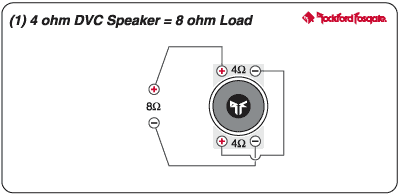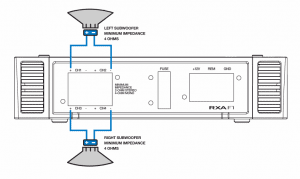Every amplifier has a specific maximum wattage when it comes to output but by bridging an amp, you can optimize its power. You can connect a SINGLE speaker of the required, You can connect MULTIPLE speakers if the total adds up to the required minimum impedance or more (see diagram), Dual-voice coil speakers can be used if they can be wired to give the correct amount, TWO 8 ohm subwoofers wired in parallel ( 8 / 2 = 4), ONE dual 8 ohm voice coil subwoofer wired in parallel (gives 4 ohms), TWO 2 ohm woofers connected in series (2 + 2 = 4 ohms), TWO 4 ohm subwoofers wired in parallel ( 4 / 2 = 2), ONE dual 4 ohm voice coil subwoofer wired in parallel (gives 2 ohms), FOUR 8 ohm woofer wired in parallel (8 / 4 = 2), Set the crossover switch to low-pass filter (LPF) or similar on your amplifier, Adjust the LPF dial, if available, to the maximum level, Play music contain bass youd normally listen to, Begin turning the LPF dial down until almost no voice or upper-range music is heard (note: for reference, a good rule of thumb is 80 Hz or lower in case youre able to know the actual cut off frequency of your amp), Adjust the gain if more higher-volume power is needed when the volume dial of your stereo is turned up, Build your own bridging module (read more, Find a bridging module (these are likely very old and hard to find, but may be possible on eBay), Use an electronic crossover with adjustable phase (0-180 degree control) for each channel and set 1 of the 2 to be 180 degrees out of phase, Pro: This allows a 2-channel amp to connect to 3 or more speakers, Con: for woofer use on the bridged output, an external passive crossover is needed these are often large, heavy, and expensive for low-frequency speakers like subwoofers. Use channels 1 and 2 for main Left and Right and bridge the remaining channels for the subwoofer. Only amplifiers can be bridged.  Often youll see the phrase stable to 2 ohms or something similar to describe what the amplifier can handle. Then run the other positive and negative to the box. Repeat steps 2 and 3 for channels three and four.
Often youll see the phrase stable to 2 ohms or something similar to describe what the amplifier can handle. Then run the other positive and negative to the box. Repeat steps 2 and 3 for channels three and four.
Also, note that in this mode each channel is handling several times the electrical current it had to before. amp ohms svc speaker ohm wire subs sub wiring load 4ohm diagram channel parallel 2ohm speakers audio isobaric dvc 6x9 {"smallUrl":"https:\/\/www.wikihow.com\/images\/thumb\/6\/6b\/Bridge-an-Amplifier-Step-1-Version-2.jpg\/v4-460px-Bridge-an-Amplifier-Step-1-Version-2.jpg","bigUrl":"\/images\/thumb\/6\/6b\/Bridge-an-Amplifier-Step-1-Version-2.jpg\/aid14973-v4-728px-Bridge-an-Amplifier-Step-1-Version-2.jpg","smallWidth":460,"smallHeight":345,"bigWidth":728,"bigHeight":546,"licensing":"
License: Creative Commons<\/a> License: Creative Commons<\/a> License: Creative Commons<\/a> License: Creative Commons<\/a> License: Creative Commons<\/a> License: Creative Commons<\/a> License: Creative Commons<\/a> That way youll get the full power capability from the amp. Since bridging means that much more power is now available to you speakers (more often than not this is used for subwoofers) its best to use a quality speaker wire and make secure, tight connections on both ends. It will also require you to make sure the impedance of your sub, which adds another layer of checks and balances to the process. To determine the max power that the amplifier can produce, you must double the max output voltage and divide the result by load impedance. The reason this is possible is that todays car amps have a design in which one of each 2 audio channels is actually inverted (you can also say 180 degrees out of phase) but is normally connected at the output in a non-inverted fashion. Make sure you verify that beforehand. This is actually a very cool and fascinating subject. The 2nd (and easier) option is to bridge the 4 main channels, skip using rear speakers, and drive the 3-way crossovers with the bridged power (should be 150W each or higher). For example, channel 1 and your second woofer to channel 2 or bridge your first woofer to channels 1 & 2 and then bridge your second woofer to channels 3 & 4. What type of amp do you have, and what is the min. Bridging a four-channel car audio amplifier will effectively double your amp's output (watts) so that you can drive more power to your speakers or subwoofers. Be aware of the fact that if your amplifier is a stereo amplifier (amplifying both left and right), bridging it would cause it to become a mono amplifier (amplifying from one; either the left or right). Hi, according to the specs the Reference 551A is rated for down to 2 ohms so youd wire the subwoofer at 2 ohms. But this process is not recommended because you will need to tinker with the gain settings to make sure that they are exact. tda2050 transistor transistors elcircuit amplifier circuit electroschematics Come inside to our Social Lounge where the Seattle Freeze is just a myth and youll actually want to hang. Most amps are capable of running a 2-ohm load, but check your amp's manual to be sure.
\n<\/p>
\n<\/p><\/div>"}, {"smallUrl":"https:\/\/www.wikihow.com\/images\/thumb\/7\/73\/Bridge-an-Amplifier-Step-2-Version-2.jpg\/v4-460px-Bridge-an-Amplifier-Step-2-Version-2.jpg","bigUrl":"\/images\/thumb\/7\/73\/Bridge-an-Amplifier-Step-2-Version-2.jpg\/aid14973-v4-728px-Bridge-an-Amplifier-Step-2-Version-2.jpg","smallWidth":460,"smallHeight":345,"bigWidth":728,"bigHeight":546,"licensing":"
\n<\/p>
\n<\/p><\/div>"}, {"smallUrl":"https:\/\/www.wikihow.com\/images\/thumb\/9\/9e\/Bridge-an-Amplifier-Step-3-Version-2.jpg\/v4-460px-Bridge-an-Amplifier-Step-3-Version-2.jpg","bigUrl":"\/images\/thumb\/9\/9e\/Bridge-an-Amplifier-Step-3-Version-2.jpg\/aid14973-v4-728px-Bridge-an-Amplifier-Step-3-Version-2.jpg","smallWidth":460,"smallHeight":345,"bigWidth":728,"bigHeight":546,"licensing":"
\n<\/p>
\n<\/p><\/div>"}, {"smallUrl":"https:\/\/www.wikihow.com\/images\/thumb\/5\/54\/Bridge-an-Amplifier-Step-4-Version-2.jpg\/v4-460px-Bridge-an-Amplifier-Step-4-Version-2.jpg","bigUrl":"\/images\/thumb\/5\/54\/Bridge-an-Amplifier-Step-4-Version-2.jpg\/aid14973-v4-728px-Bridge-an-Amplifier-Step-4-Version-2.jpg","smallWidth":460,"smallHeight":345,"bigWidth":728,"bigHeight":546,"licensing":"
\n<\/p>
\n<\/p><\/div>"}, {"smallUrl":"https:\/\/www.wikihow.com\/images\/thumb\/f\/f9\/Bridge-an-Amplifier-Step-5-Version-2.jpg\/v4-460px-Bridge-an-Amplifier-Step-5-Version-2.jpg","bigUrl":"\/images\/thumb\/f\/f9\/Bridge-an-Amplifier-Step-5-Version-2.jpg\/aid14973-v4-728px-Bridge-an-Amplifier-Step-5-Version-2.jpg","smallWidth":460,"smallHeight":345,"bigWidth":728,"bigHeight":546,"licensing":"
\n<\/p>
\n<\/p><\/div>"}, {"smallUrl":"https:\/\/www.wikihow.com\/images\/thumb\/6\/6f\/Bridge-an-Amplifier-Step-6-Version-2.jpg\/v4-460px-Bridge-an-Amplifier-Step-6-Version-2.jpg","bigUrl":"\/images\/thumb\/6\/6f\/Bridge-an-Amplifier-Step-6-Version-2.jpg\/aid14973-v4-728px-Bridge-an-Amplifier-Step-6-Version-2.jpg","smallWidth":460,"smallHeight":345,"bigWidth":728,"bigHeight":546,"licensing":"
\n<\/p>
\n<\/p><\/div>"}, {"smallUrl":"https:\/\/www.wikihow.com\/images\/thumb\/3\/30\/Bridge-an-Amplifier-Step-7-Version-2.jpg\/v4-460px-Bridge-an-Amplifier-Step-7-Version-2.jpg","bigUrl":"\/images\/thumb\/3\/30\/Bridge-an-Amplifier-Step-7-Version-2.jpg\/aid14973-v4-728px-Bridge-an-Amplifier-Step-7-Version-2.jpg","smallWidth":460,"smallHeight":345,"bigWidth":728,"bigHeight":546,"licensing":"
\n<\/p>
\n<\/p><\/div>"}, https://www.youtube.com/watch?v=8p88aCFgJMY, https://www.youtube.com/watch?v=KuaWvMjvZkM, Fazer uma Ponte ou Bridge em um Amplificador. The power of any amplifier depends on the voltage it produces and the speakers impedance. Note: it may be necessary to set the built-in low-pass crossover also, if available. A lot of cars with amplifiers come with a setting called bridge mode or bridging. 300 Watts x 1-Channel @ 4 Ohm How does an amp make more power when bridged?  There are a few advantages to doing this with your audio equipment. Don`t interchange their connections (+ of one vc to - of another). Want more? Surely - this is possible. There is the low-pass filter, high-pass filter and subsonic filter. Channel 4 will have G for positive and H for negative. The voltage available across amps bridged channels working togetherin a push-pull fashion is: Power across the 4 ohm subwoofer: V x V / R = (28.28)*(28.28) / 4 = 800 / 4 = 200W in bridged mode. But before that, you must keep in mind that the amplifier has enough load to support the power supply coming in. So, thats where we shall begin. All tip submissions are carefully reviewed before being published. Last Updated on March 8, 2022 by Danny Reid.
There are a few advantages to doing this with your audio equipment. Don`t interchange their connections (+ of one vc to - of another). Want more? Surely - this is possible. There is the low-pass filter, high-pass filter and subsonic filter. Channel 4 will have G for positive and H for negative. The voltage available across amps bridged channels working togetherin a push-pull fashion is: Power across the 4 ohm subwoofer: V x V / R = (28.28)*(28.28) / 4 = 800 / 4 = 200W in bridged mode. But before that, you must keep in mind that the amplifier has enough load to support the power supply coming in. So, thats where we shall begin. All tip submissions are carefully reviewed before being published. Last Updated on March 8, 2022 by Danny Reid.  Again, run speaker wire from the positive terminal of channel 3 to the positive terminal of subwoofer two. Weve got the Jackd Fitness Center (we love puns), open 24 hours for whenever you need it. Can I wire 1 kappa 1200W set at 2 ohms to a Ref 551a bridged. Simply handle the two voice coils like they were from two separate speakers. If youre interested in buying a 4 channel amp, take a look at the best 4 channel amp article. Its easy to make mistakes and unfortunately you can permanently damage your amplifier and even your speakers. Hi there, we're so glad that you have found us. You just need to connect a few wires and there you have it. You can fix that by getting a bigger amplifier but a 50-watt amplifier will increase the sound level only by three decibels and the power will need to be 10 times what you usually need.
Again, run speaker wire from the positive terminal of channel 3 to the positive terminal of subwoofer two. Weve got the Jackd Fitness Center (we love puns), open 24 hours for whenever you need it. Can I wire 1 kappa 1200W set at 2 ohms to a Ref 551a bridged. Simply handle the two voice coils like they were from two separate speakers. If youre interested in buying a 4 channel amp, take a look at the best 4 channel amp article. Its easy to make mistakes and unfortunately you can permanently damage your amplifier and even your speakers. Hi there, we're so glad that you have found us. You just need to connect a few wires and there you have it. You can fix that by getting a bigger amplifier but a 50-watt amplifier will increase the sound level only by three decibels and the power will need to be 10 times what you usually need.
Sitemap 25